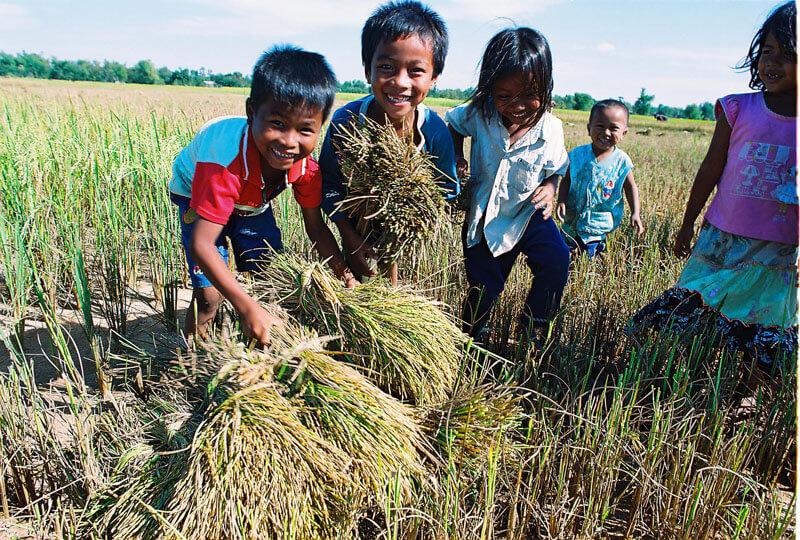Kat KelleyGHTC
Kat Kelly is a senior program assistant at GHTC who supports GHTC's communications and member engagement activities.

When most people think of hunger, they think of a lack of food—a nation suffering from crop failure and famine, or a family that can’t afford to put enough food on the table. But hunger is a far more complex issue with many dimensions. Tackling hunger is not only about ensuring reliable and affordable access to food, but access to the right types of food that are rich with the nutrients human bodies need to function and thrive.
Two billion people—more than a quarter of the world’s population—suffer from micronutrient deficiencies, an affliction GHTC member HarvestPlus calls “hidden hunger.” Micronutrient deficiencies, or insufficient amounts of vitamins and minerals, including vitamin A, zinc, and iron, are a major public health problem, particularly in developing countries where people’s diets rely on inexpensive staple crops that often lack nutrients. While those affected may not show the visible symptoms of hunger and malnutrition, micronutrient deficiencies can still have a devastating impact on health, resulting in stunting, blindness, and lowered IQ in children, as well as increased vulnerability to infectious diseases and complications in pregnancy and childbirth.
This World Food Day, we’re joined by Peg Willingham, head of Advocacy and Policy at HarvestPlus, to discuss biofortification—an innovative approach to tackling hunger and malnutrition.
What role can biofortification play in eradicating hunger, and in particular, micronutrient deficiency?
PW: Ideally, everyone should have access to fruits, vegetables, and protein, or to important interventions like vitamin supplements. Unfortunately, these are often out of reach for smallholder farmers who subsist on the food they grow on an acre or two of land—which constitutes the majority of people living in developing countries. A cost-effective new tool to target these families is biofortification—using conventional breeding techniques to increase the levels of vitamins and minerals in the most widely consumed staple foods in Africa, Asia, and Latin America.
Can you talk a bit about the process of biofortification and how these crops are introduced and scaled up in developing countries?
PW: Until recently, crop developers have focused on higher yield per acre and resistance to diseases, pests, drought, and heat. With support from HarvestPlus, researchers are now including nutrition as an important trait. They search existing seeds banks—which contain 300,000 plant varieties—to identify ones that are naturally high in these important micronutrients, but which cost the same, produce the same yield, and don’t require any extra inputs like more water or fertilizer. National agricultural research authorities around the world then test these crops locally to make sure they grow properly in different soils and climates.
We then work with a broad array of partners to get these healthier crops to farmers. This varies from country to country and from crop to crop. For example, most farmers in Zambia buy their corn seed from local private companies, so we work with those firms to get them to make the switch to seeds that are high in vitamin A. In Uganda, farmers who receive donated vitamin A sweet potato vines share them with other farmers the following season, in a constantly expanding cycle. Ten million people are currently growing and eating these healthier foods in more than 30 countries, and testing is underway in almost 20 more countries.
What’s in HarvestPlus’ pipeline of biofortified crops? What crops have already been released or are currently in development?
PW: Biofortification is centered on the staple foods that people already eat regularly. More than a dozen crops are currently available to farmers: bananas, beans, black-eyed peas, cassava, corn, lentils, pearl millet, plantains, potatoes, pumpkin, rice, sorghum, sweet potato, and wheat. We are excited by recent data demonstrating the nutritional impact of biofortified crops. A study in Mozambique showed vitamin A sweet potatoes significantly reduced the incidence and duration of diarrhea, one of the leading causes of mortality in African children. Pearl millet extra rich in iron was able to reverse iron deficiency in school-aged Indian children in six months. More studies are underway.
What role can policymakers—at the national level, as well at the multilateral and global level—play in advancing biofortification and other innovations to improve nutrition?
PW: We have been gratified to see how quickly policymakers have embraced this innovation, paving the way for better health and livelihoods. The World Bank has begun funding countries to scale-up biofortification, and the African Union’s commissioner for Rural Development and agriculture and health ministers around the globe have publicly endorsed it. Several countries have included biofortification in their national health and agriculture strategies and are investing their own money in scaling-up access. Additional resources will accelerate this process.